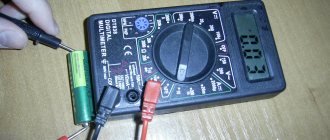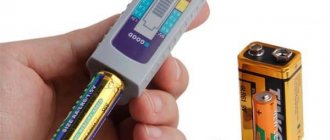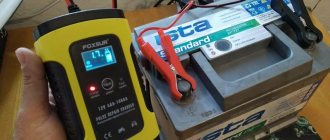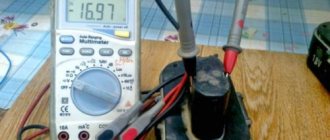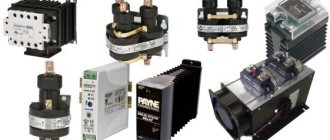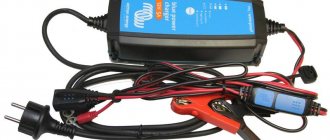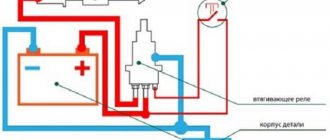The battery is an important component, without which the car simply will not run. Many drivers treat the battery as a consumable item - they replace it with a new one when it starts to act up. Power supplies “age”, but this can be slowed down if they are serviced on time and operating rules are followed. Testing the battery with a multimeter will allow you to evaluate its performance.
Checking the battery with a multimeter is necessary in order to notice possible malfunctions in time.
How to check the battery
When learning how to measure battery capacity with a multimeter, you need to consider the procedure for a vehicle battery.
A full check of the autonomous power source will allow you to avoid problems in the vehicle’s electrical network and extend the life of the battery. First, the battery must be disconnected from the machine system. It is allowed to disconnect only the “minus” contact. Next you need to turn on the multimeter. The test mode is set to the range from 0 to 20 V.
The multimeter probes are connected to the battery contacts. A red wire is connected to the positive terminal, and a black wire is connected to the negative terminal. If this procedure is performed correctly, the measurement result will appear on the device screen.
Measurements while the engine is running
Place the car on a level surface, open the hood, put the handbrake on and start it. When the engine is running, the generator and voltage regulator operate, which charge the battery. Therefore, the voltage at the terminals should be within 13.5-14 volts. In some cars, when the battery is discharged and the air temperature is low, the electronics automatically increases the voltage to speed up charging. In this case, it should fall smoothly as it charges. If this does not happen, the electrolysis process is activated in the banks. The electrolyte will begin to boil away rapidly. Overcharging is especially dangerous for modern gel batteries with limited gas emissions.
A voltage of less than 13.4 volts is a sign of undercharging. Operating in such conditions promotes sulfation of the plates and shortens battery life.
When measuring voltage, you need to turn off all powerful consumers: headlights, heater, audio system. Otherwise, the power of the generator when idling will not be enough to maintain the optimal voltage level.
There are several possible reasons for low voltage at the terminals:
- Poor contact.
- Generator failure.
- Voltage regulator malfunction.
You cannot operate a machine whose battery is in undercharge mode. The cause of the failure must be immediately localized and eliminated. If the voltage at the terminals and the output of the generator is very different, you need to clean the contacts on the battery with sandpaper or a file.
After checking without load, you need to turn on the headlights and other powerful energy consumers, add engine speed and repeat the measurements. If at high speeds under load the voltage drops to 13.4 volts or lower, diagnostics of the generator system and control unit is required.
How to test a battery with a multimeter with the engine turned off?
The average indicator, when checking the battery with a multimeter, with the engine not running, should be in the range of 12.5–13 V, with the upper value indicating 100% charge, and the lower value indicating 50%. The numbers are approximate, but the general picture is easy to understand. Also, do not forget that you should take readings immediately before the trip, and not after it, as soon as you have turned off the engine. It is especially good to carry it out when the car has not been used for some time, for example, in the morning after a night in the garage. This shows how well the battery can hold a charge.
Now you understand how to check the charge of a car battery with a multimeter. This device is worth purchasing for every motorist. Some rely on the on-board computer, but it does not provide sufficient accuracy. The built-in voltmeter is connected to the circuit of devices that consume energy, and not directly to the battery, therefore, part of the electricity is consumed “on the road”.
Table of battery charge level depending on electrolyte density
| Charge level (%) | Electrolyte density (g/cm³) | Degree of discharge (%) | Battery voltage (V) | Charge time at 10% capacity (hours) |
| 100 | 1,277 | 0 | 12,73 | Not necessary |
| 90 | 1,258 | 10 | 12,62 | 2 |
| 80 | 1,238 | 20 | 12,50 | 4 |
| 70 | 1,217 | 30 | 12,37 | 6 |
| 60 | 1,195 | 40 | 12,24 | 8 |
| 50 | 1,172 | 50 | 12,10 | 10 |
| 40 | 1,148 | 60 | 11,96 | 13 |
| 30 | 1,124 | 70 | 11,81 | 16 |
| 20 | 1,098 | 80 | 11,66 | 20 |
| 10 | 1,073 | 90 | 11,51 | 24 |
| 0 | 1,06 | 100 | 11,4 | Sulfation |
The degree of charge of a battery can be judged by the density of its electrolyte. The lower the density, the more the battery is discharged.
How to check battery capacity
We found out that checking the battery's state of charge with a measuring device is not only possible, but also not difficult at all. But is it possible to check the battery capacity with a multimeter? This question still needs to be sorted out. This can be done if, in addition to the measuring device, you use an artificial load and a clock (timer).
Additional information: The load function is performed by two halogen lamps, and a timer found in any phone is suitable for measuring time intervals.
The total power of the light bulbs will be equal to 110 Watts, and the current flowing through them will be about 8.5-9 Amperes.
To measure the battery capacity you will need to do the following in the sequence below:
- First you need to fully charge the battery being tested.
- Then you should connect a load and a multimeter to the terminals, the switch of which is switched to voltage measurement mode.
- When connecting them, you should note the time and wait until the voltage at the terminals drops to 10.3 Volts.
- Having determined by the clock the time this reading was taken, we calculate the interval during which the battery was completely discharged.
Let it be equal to 6.5 hours. Checking the capacity with this data is very simple: you need to multiply the resulting time in hours by the discharge current in amperes. The result is the battery's energy capacity in amp-hours. In our case, it has a value of 6.5x8.5 = 55 A/hour.
Please note: If the passport of the most tested battery shows the figure 60 A/h, then it is in satisfactory condition and you can continue to work with it.
During operation, you should always remember that car batteries do not tolerate deep discharge well. Therefore, it is necessary to constantly monitor the voltage at its terminals, which is directly related to the value of the capacitance. If a drop in this indicator is detected below 10.3 Volts, it will be necessary to carry out a control check of the energy intensity in the manner described above. Upon completion, it is imperative to restore the battery’s functionality with a carefully selected charging current.
Another way to determine battery capacity is to take measurements using a battery capacity tester.
Battery capacity tester
Voltage check
The voltage at the battery terminals is the main indicator of its performance and the possibility of further operation. Before measuring the voltage at its terminal contacts, you will need to perform the operations in the order listed below:
- First, the battery itself is prepared, for which its surfaces in the terminal area are thoroughly wiped with a rag.
- Then you need to switch the prepared multimeter to the appropriate mode (“voltage”) and proceed to measuring the parameter.
- Next, select the reading limit (for this case, “20 Volts” is suitable).
After this, the measuring probes of the device will be connected to the corresponding terminals of the battery (the wire in red insulation is to the plus, and the black wire is to the minus). In conclusion, the obtained readings should be compared with the standardized values.
Please note: When checking the battery voltage with a multimeter, the device should show a value in the range from 12.6 to 13.0 Volts.
With lower readings, the battery needs to be recharged, which requires a special charger (charger).
Criteria for evaluation
When assessing the current condition of the battery, it is necessary to proceed from the following criteria:
- battery voltage readings in the range of 12.6-13.0 Volts indicate that the battery is well charged and fully ready for use;
- values of 12.1-12.4 Volts are a sign that the battery is not fully charged and needs to be recharged;
- 11.6-12.0 Volts indicate a strong discharge of the battery, which is unsuitable for operation;
- readings less than 11.0 Volts mean that the device is completely discharged and requires special recovery procedures.
To resuscitate a completely dead battery, you will need to carry out a series of recovery operations described in the corresponding section.
How to check battery amperage
To determine how the battery amperage is checked with a multimeter, the user will need to create a special load circuit. Either halogen lamps or a special load plug can be used as a consumer.
To measure the battery current with a multimeter, you must do the following:
- Switch the multimeter to the “Amperes” mode at the limit of 10 A (20A).
- Connect the red test probe of the device to the positive terminal of the battery, and the second (black) to one of the 2 load contacts.
- Its second contact must be connected to the negative terminal of the battery.
Please note: As a result of these actions, a sequential closed circuit will be obtained, in which the current will flow through each element, including the measuring device.
Its display will display a reading corresponding to the load current value.
Checking internal resistance
Using a universal multimeter type device, you can check the battery for its internal resistance. To carry out such measurements, you will also need a special load (its function is usually performed by an ordinary 60-watt halogen light bulb with a current consumption of about 5 Amperes.
Additional Information. According to current standards, voltage loss across the internal resistance of the battery at 100 amperes of load current should not exceed 1 Volt (1%).
When recalculated for a current load of 5 Amps, the corresponding losses should not be more than 0.05 Volts.
To check the resistance of the plates in a battery with a multimeter, you will need to perform the following series of operations:
- First you need to connect a halogen lamp to the battery terminals and wait until it starts to glow.
- Immediately after this, you will need to measure the voltage at the terminals using a multimeter and record the resulting reading.
- Then you need to disconnect the lamp from the battery and again record the voltage value at its terminals.
At the final stage of the test, the difference between the two readings obtained (without load and with load) should be determined. If this value does not exceed 0.05 Volts, then the battery being tested has a sufficiently low resistance and does not reduce the operating voltage. Otherwise, you will have to accept that the battery is very worn out and needs to be replaced.
How to Visually Check a Car Battery Case and Cables
Now it's time to check the physical condition of your battery. A damaged battery case can not only prevent the battery from working properly, but can ultimately kill it. To check it, you need to remove it from your car.
Disconnect the cables first, starting with the ground terminal and then the positive terminal. Now unscrew the clamping mechanism to remove the battery from the tray. Make sure the holding mechanism works. If it doesn't exist, install it. This equipment prevents the battery from rebounding and becoming damaged while the vehicle is in motion.
Place it on a work surface or similar surface. Carefully inspect the battery case for possible damage. Check for a bulging side or cover, cracks around the housing, or damaged terminals. If your battery is damaged, replace it. Overcharging and internal short circuit will cause the battery to swell as the acid turns to gas. So if you notice signs of a bulge, check the charging system as well.
Now check the cables. Check the insulation around the cables and the condition of the cable threads for wear, cracks or fraying. Replace them if necessary. Make sure the clamp mechanism on your battery is working.
Multimeter indicators
A multimeter is a popular tool not only for motorists. It is used in any area where it is necessary to measure current: voltage, resistance and its strength.
Its versatility is characterized by the fact that the device includes the following:
- Voltmeter.
- Ammeter.
- Ohmmeter.
The device is compact and can be easily carried and stored in a car. Thanks to constant use to check the condition of the battery, it can be maintained in working condition for a long time.
There are several versions of such a device.
When choosing it, it is recommended to pay attention to the following:
- measurements are carried out ranging from 0 to 200 mV, as well as 2 V, 20 V, 200 V, 1000 V.
- DC current can be measured within 2 mA, 20 mA, 200 mA.
- The alternating voltage ranges from 0 to 200 V, 750 V.
- Resistance can be measured from 0 to 200 ohms.
There are more complex versions of the multimeter.
What parameters can be checked?
Using a multimeter, you can measure voltage with high accuracy. By the magnitude of the electrical voltage, you can determine whether the battery is charged or the element needs to be charged with direct current.
Using a multimeter, you can check the voltage not only of acid batteries, but also of cell phone batteries. To check the mobile phone's battery charge level, the device is switched to the mode for measuring direct current up to 20 V. In this mode, the digital device allows you to measure voltage with an accuracy of hundredths of a volt.
The screwdriver battery can also be easily checked with a multimeter. The rated voltage of the device, in this case, can be found out from the documentation of the power tool, and if the voltage is less than this value, then the battery must be charged.
The battery capacity can also be checked with a multimeter. For this purpose, you can use several methods.
You can check current leakage using a multimeter. If it is necessary to measure this parameter on a car, then in addition to the current leakage on the body, the leakage in the vehicle’s on-board network is also checked.
In this way, you can prevent rapid discharge of the battery and increase its service life.
How to check battery charge with a multimeter?
Determining the condition of a lithium-ion (the most common type of modern battery) battery is quite simple if you follow these instructions:
- Disconnect the energy storage device from the car and wait 5-6 hours.
- The multimeter should operate in the “voltage” mode (voltage test).
- A standard lithium battery produces current in the range of 12.7–13.2 volts. The switch is set to 20 or closest to it. This is how the voltage is measured from this value and below.
- The wires coming from the device are connected to the battery: red to the positive terminal, black to the negative terminal. If the wires are the same color, then you should focus on their markings and connect them to opposite charges, minus to plus and vice versa.
Checking mobile phone capacity
You can check the battery capacity of your mobile device using a simple tester. A situation often occurs when the energy source fails almost instantly. Rapid loss of capacity occurs when using Power Bank type chargers. They can significantly speed up the charging process, but with constant use of such charging, the service life of the energy source is significantly reduced.
For mobile phones that run on popular operating systems, there are also a large number of different programs for testing the battery. iBackupBot is considered the most popular.
It is used as follows:
- It is recommended to first download and install it on your computer.
- After this, the mobile device is connected via cable.
- When you launch the program on the left side of the main screen, you will see the “More information” item. It displays the number of cycles and capacity indicator.
Recently, mobile devices of Chinese origin have become widespread. For these, it is recommended to install the Battery application, which can display the following information:
- Battery temperature (if there is a corresponding sensor).
- Voltage and capacity.
Recommended: What you need to know about ni mh batteries
Programs do not display accurate information and should not always be taken into account. More accurate readings can be obtained by using a conventional tester.
Checking the main indicators using a tester is carried out in most cases. Recommendations for performing this work are as follows:
- Before performing the test, the battery should be completely discharged.
- The measuring device in most cases has a USB cable.
- After the battery is completely discharged, the device is connected to the tester.
When performing the test, you need to wait a little, since the capacity value increases over time. The optimal indicator for mobile phone batteries is considered to be 2100-2200 mAh. If the indicator is 50% less than what is indicated in the specification, then the power source should be replaced.
Using a hydrometer to check battery fluid
- Remove the caps from the top of the battery.
- Immerse the tip of the hydrometer into the first cell of the battery and squeeze out the hydrometer bulb.
- Release the bulb so that the electrolyte enters the hydrometer needle.
- Read the specific gravity of the electrolyte as indicated in the instructions on the tool packaging.
- Record your values and perform the same test on the remaining cells.
- Compare your results with the results of the tool manufacturer's instructions.
Basically, if your readings fall between 1.265 and 1.299, your battery is charged. When your readings drop below 1.265, your battery will not be sufficiently charged. In most cases, a slow or fast charge will help restore charge and improve the chemistry in the battery. However, a difference between 25 and 50 points or more (the point is 0.001) between any of your readings indicates that the battery is sulfated and you need to replace it.
Check discharge method
Checking the battery
You can find out the capacity of a phone, car or screwdriver using the test charge method. The unit’s battery should be fully charged and then loaded so that the discharge current strength is equal to the value indicated in the battery passport of a telephone or car.
In order to measure this indicator accurately, it is worth including a multimeter in the resulting circuit. The indicator should be written down, after what time the current strength will decrease by approximately half.
This number should be compared with the passport of the battery of a car or phone, because if the difference between the indicators is small, then everything is in order. If you measure the indicator and see a big difference, then the battery is most likely already out of order.
How to check the battery charge using the indicator
Many maintenance-free batteries have charge indicators that allow you to visually determine the condition of the battery. This option first appeared on Japanese products and quickly gained popularity due to its convenience and accessibility.
The hydrometer, as the indicator is called, is a transparent window on the battery cover. The color of the window changes depending on the condition of the battery:
- Green —full charge.
- Gray or white - need to be charged.
For some indicators, the window turns red when capacity is lost.
The principle of operation of the device is based on changes in the density of the electrolyte at different charge levels. It works like this:
A tube with a green float is attached to the window.
- When charging the battery, the density of the electrolyte increases and the float rises, approaching the window.
- If the battery is discharged, the density drops and the ball sinks in the electrolyte. As a result, the indicator window changes color to gray or black.
Some indicator models have a red ball that floats up when the density of the electrolyte decreases. This provides a red indication of the discharge.
When the electrolyte level drops, not the ball, but the electrolyte itself will be visible through the window. To prevent the destruction of the plates, you need to add distilled water to the jars and charge the battery.
The advantage of the indicator is that the device allows you to determine the condition of the battery without the use of special instruments. This is convenient when purchasing a battery or in road conditions when you need to quickly check the condition of the battery. However, indication using a float does not always allow one to draw accurate conclusions about the performance of the battery. Therefore, when in doubt, you should use a multimeter or a load fork. They are also useful when you need to check a battery that is not equipped with an indicator.
Applicable verification methods
In addition to the multimeter, other methods for checking a car battery can be used. The following are common:
- The design of older car batteries makes it possible to measure the density of the electrolyte. However, modern versions are characterized by a sealed housing that does not have holes for measurements.
- The load fork has become widespread. It is represented by a handle with two probe terminals that connect to the power source. The device has a scale from which the required information is read.
- A special tester for lead-acid batteries is an electronic device that is capable of providing all important parameters within a few seconds: voltage, capacity, estimated service life.
- Test charge is another method that is used extremely rarely today. Its features include the need to fully charge and connect a certain load. A test like this takes quite a lot of time.
For frequent battery testing, it is recommended to purchase a special tester. Its cost can be several tens of thousands of rubles. It only takes a few seconds to check the status of the power supply when using it.
How to Test Battery Terminals Using a Multimeter
Dirty, corroded or loose terminals will lead to starting or no-starting problems and are one of the main reasons people think they have a "dead battery". Sometimes such problems are difficult to detect with a simple visual inspection.
Here you will use a voltmeter (or multimeter set to voltage) to check the battery terminals for voltage drop so you can understand the status of your battery connections.
First turn off the ignition system. Do this by temporarily disconnecting the ignition coil or removing the fuse, or the fuel pump relay (if necessary, find your vehicle's owner's manual or your vehicle's repair manual to locate the coil or fuse). This will prevent your engine from starting.
Use the red positive wire to touch the positive terminal of the battery and hold. Touch the black wire (negative) of your meter to the terminal of the negative wire that goes onto the battery. Have a helper crank the engine. If your meter registers more than 0.5 volts, you will need to clean or check the physical condition of the terminal and terminals.
Now check the other battery terminal. This time, however, use the black probe of your meter to touch the negative terminal of the battery. Now touch the red probe of your meter to the cable terminal connecting to the same battery terminal. Have your helper start the engine and check the voltage reading on your meter. If it exceeds 0.5 volts, you need to check the battery terminal for damage or clean it.
How to measure voltage?
If it is necessary to measure the vehicle battery voltage, select the DC function. If you need to check a battery that produces a voltage of no more than 20 V, activate the corresponding function. Modes are selected using a switch. The black probe of the measuring device is connected to the negative terminal, the red one to the positive terminal.
The voltage value of the current supplied by the battery will appear on the device screen. For a working car battery, this parameter is 12.7 V.
If at a given voltage the electrolyte density is within normal limits, the power source is suitable for use.
A similar method is used to measure the voltage of batteries in cell phones, laptops and tablet computers. The multimeter is also used to check the batteries of motorcycles and generators that require starting current.
How to check the “amperage” of a battery with a multimeter?
To determine the current that your battery produces, you will need to create a circuit with a load. Its role is played by any device or equipment that consumes electricity. To take measurements you will need to take the following steps:
- The device is set to ampere measurement mode, and the switch on it is set to alternating current, which is designated by the English letters AC.
- Disconnect the positive terminal of the battery and replace it with the negative wire of the measuring device.
- To the equipment that acts as a load, connect the negative terminal of the battery and the meter probe with a positive charge.
- Depending on the design, look at the displayed number or count it on the instrument scale.
A serviceable and fully charged battery exhibits readings in the range of 12.6–13 V.
Battery testing of tools
Some tools, for example, a screwdriver, are powered by a built-in battery. You can check the battery capacity in various ways; testing is recommended periodically. Among the features of checking instruments, the following points should be noted:
- Before measuring capacitance, the current voltage value is determined. The indicator is taken while the battery is charging. Within 30 minutes after connecting the battery, the first readings are taken when using a multimeter. It should be around 13 V.
- The next few measurements are taken after half an hour and two hours. The readings should be 13.5 V and 14 V, with a full charge of about 17 V.
- Voltage readings that are too low indicate that some parts of the battery may have failed. Individual energy sources are connected in series, thereby increasing the voltage value.
- When measuring capacitance, an additional load is required, which is often a 10 V light bulb.
- A light bulb is connected to a fully charged battery using two wires. It begins to burn, after which the time required to completely discharge the energy source is recorded. For a device of Chinese origin, it will take about 2.5 hours.
- If the light bulb disappears quickly, this indicates a small capacity. It can be calculated as follows: 10 W/18 V x 0.5 hours. This formula uses the load indicator, voltage (measured with a multimeter) and the time it took for the battery to lose its charge. In the case under consideration, the indicator is 0.28 amperes per hour, which indicates the need to replace the source of electricity.
If the tool is used frequently, it is recommended to check it periodically. If the container drops significantly, it can only be used for a few minutes. It is almost impossible to restore the battery; you have to replace it.
How to test a battery with a load fork?
This is the most accurate method to determine the state of charge and the ability of the battery to operate at full load. It is used by professional auto electricians in service centers.
A load fork is a device that combines a voltmeter and a load resistance. Advanced versions of the device are also equipped with an ammeter, which allows you to estimate the load current. The fork operates in two modes:
- battery voltage measurement;
- imitation of starter operation.
Before starting the test, you should turn on the voltmeter mode on the load plug and connect it to the battery. If the device shows less than 12.7 volts, the battery needs to be charged.
| Voltmeter readings under load | >10.2 V | 9.6 V | 9.0 V | 8.4 V | <7.8 V |
| Charge percentage | 100% | 75% | 50% | 25% | 0% |
Check internal resistance
Resistance is an important indicator of battery health. To measure the parameter, you will need a universal tester and a powerful lamp.
Multimeter markings.
The procedure is performed like this:
- Connect the 12 Volt lamp to the battery. After 10-15 seconds, determine the voltage at the battery terminals.
- The lighting device is turned off. The voltage is measured again. If the difference between the 2 values does not exceed 0.05 V, the battery is operational. If the voltage drops are more pronounced, the battery resistance is considered high. This indicates a deteriorating condition of the power supply.
Reinstalling the battery
After cleaning the case, terminals and tray, reinstall the battery.
- Carefully place it on the tray.
- Attach to tray using clamping mechanism.
- Connect the terminals. This time, start with the positive terminal and connect the negative or ground terminal last.
- After connecting the terminals, spread a thin layer of Vaseline around the top of the terminals and terminal posts. This prevents corrosion from accumulating around the terminals.
Leakage current measurement
The minimum leakage current can be found in almost any car, even in new models . This is due to the fact that some car systems consume minimal electricity even when the engine is turned off or when the key is not in the ignition.
In different sources, the indicator of such current ranges from 10 to 80 mA. A large leakage indicates that the vehicle's electrical equipment is in a faulty condition. A leakage value of 60 mA determines that a battery in this condition can last for many years if used properly.
A situation where the battery is not charged for several days has a much more negative impact. You can also measure leakage using a multimeter.
The measurement procedure is as follows:
- We set the measurement mode to 10 A or 20 A. It is best to set a higher value if the device used allows it.
- It is recommended to check if the mass breaks from a safety point of view.
- Remove the negative terminal.
- one of the probes to the battery negative.
- the other one to the removed wire.
- We get a certain result.
For an accurate indicator, you should properly prepare the car:
- We turn off the interior lighting, turn off the radio and other consumers.
- Remove the keys from the ignition.
Quick battery check
In some cases, car owners have absolutely no time to disconnect the battery from the car, as well as “digging” with the lighting and dashboard. Such car owners determine the battery charge level without removing it, right under the hood.
The process looks like this:
- When the car freezes after turning off the engine, the multimeter is connected to the battery according to the scheme: plus to “+”, minus to “minus”, respectively. It is worth considering that the indicators will have minor deviations. 12.7 Volts is a normal indicator.
- Then the car starts. When the motor starts, the voltage will rise to 14.7 Volts.
- It is recommended to check it under load (external lighting, window heating, medium heater mode). In this case, the norm is 14.6 Volts.
Measuring the voltage of a car battery with a multimeter is a feasible task even for a novice car enthusiast. Not everyone can afford an expensive battery equipped with a special indicator.
A practical and universal option is to measure the battery charge with a multimeter. This device, with a talking prefix “MULTI”, allows you to measure not only voltage, but also current. In addition, the multimeter can be useful for other electrical equipment, including phones, laptops, and screwdrivers. Remember that it is better to purchase such a device from trusted manufacturers in specialized stores.
Other ways to check a car with a multimeter
The cause of battery failure, voltage surges or incorrect operation of the dashboard is a malfunction of the sensors. The location of the parts can be found by reading the vehicle's operating instructions.
ABS sensor
In this case, you need to check the resistance and voltage. Start by choosing the appropriate mode. The normal resistance is 1.2-1.8 kOhm. The multimeter is connected to the sensor, and the wires going to the part are moved. If the value on the tester screen increases or decreases, the sensor requires repair. Measuring voltage is more difficult. To do this, you need to spin the car wheel while monitoring the multimeter readings. The normal sensor voltage is 2 V.
Crankshaft sensor
The part is triggered the moment the engine starts. If it malfunctions, the car cannot start. If there are no visual signs of failure, use a multimeter. The device is switched to resistance measurement mode and connected to the sensor. The norm is 550-750 Ohms.
Oxygen sensor
This device detects residual oxygen in exhaust gases. Before checking, the sensor is inspected for damage. If there are no visible signs of malfunction, measure the resistance and voltage. After starting the engine, observe the instrument readings.
At the moment of startup, the number 0.1-0.2 appears on the screen. After the car warms up, the voltage rises to 0.9 V. If the reading differs from normal, the sensor is faulty. A resistance of 10-40 ohms is considered normal.
Knock sensor
The sensor is used to detect the shock wave generated during fuel combustion. The amount of resistance depends on the car model. To measure the voltage, the sensor is dismantled, the positive probe of the multimeter is connected to the signal wire, and the negative probe is connected to ground. The part needs to be hit against a wall or floor. This is the only way the device can record the voltage. The normal value is 30-40 mV.
How to clean a car battery
- Cleaning the battery case
You can use a simple procedure to clean the battery case. To do this, you need to prepare a mixture of 8 ounces of warm water and one tablespoon of baking soda. This neutralizes the acid and helps remove dirt from the battery case and terminals.
Wear safety glasses and rubber gloves and, using a soft brush, apply the solution to the top of the battery and the sides of the case. If your battery uses compartment caps (serviceable batteries), do not allow the mixture to seep under the caps and mix with the electrolyte inside.
Wipe with the solution and a clean rag. Continue applying the cleaning solution until you see no signs of buildup.
- Cleaning the Battery Terminals
As with the battery, remove dirt and corrosion from the terminals using baking soda and a water solution.
To make your task easier, pour the mixture into a Styrofoam or similar disposable cup and submerge the battery terminal in it for a minute or two. Next, use a battery compartment cleaning tool to finish removing corrosion from the terminals. Repeat the procedure until you see that both cables are free of corrosion.
- Cleaning the battery compartment
Check the condition of the battery compartment. Make sure there are no screws, cracks, pieces of dirt or signs of corrosion. If necessary, use the same solution to remove dirt and corrosion from the pan.
Battery voltage measurement
An important indicator of a battery is its voltage. That is why many measure this particular indicator.
With the engine running, it is possible to measure the voltage. A normal voltage is considered to be between 13.5 and 14 V. But a voltage above this value when the engine is running indicates that the battery is low charged and the voltage regulator supplies more energy from the generator to charge it. It is worth considering that this is a common occurrence in winter, since the battery can be seriously discharged overnight.
Read also: How to cut protective glass for a smartphone
An increase in battery voltage is a phenomenon that you should not be afraid of. If everything is in order with the technical condition of the vehicle’s electrical equipment, after 10 minutes the voltage indicator will stabilize and will be within 14 V.
However, if after 10 minutes this does not happen, then you should think about the state of the voltage regulator. Constant operation at such indicators can lead to boiling of the battery. Another phenomenon that determines the problem with an incorrect voltage indicator is the passage of the oxidation process on the contacts.
To prevent this phenomenon, you need to clean the contacts. If the voltage drops below 13 V, the battery should be replaced, since such data indicates its malfunction.
When taking measurements while the engine is off, the following nuances can be highlighted:
- A voltage of less than 12 V may result in the car not starting, especially during cold weather. When the ambient temperature drops, the engine oil thickens, and the properties of the fuel also change. Therefore, the battery cannot crank the crankshaft, since more effort is required under such conditions.
- The normal voltage , which will be sufficient to start the engine, can be considered 13 V.
- The measurement should not be taken immediately after the end of the movement, but before it begins.
- A high charge level indicates the battery’s ability to hold voltage for a long time. The lower the charge level, the faster its loss occurs. Therefore, new batteries or those that are in good technical condition are able to maintain their functionality for a long period of time even without recharging.
How to make a device with your own hands
When the necessary equipment is not available, you can make the device yourself by watching the video. It is necessary to take a voltmeter from ready-made instruments, and the remaining parts are constructed from improvised means. Difficulties will arise when calculating and creating internal resistance, which requires current.
A suitable material is nichrome wire, used to create heating coils in electric stoves. Nichrome elements can be replaced with a metal strip from other heating devices.
For a voltage of 12 V, the current indicator should be within 80-120 Amperes, and the resistance should be 0.1-0.15 Ohms. A device for measuring such resistance is difficult to find. For this reason, the length of one element is selected and the current that it passes is measured. After this, several similar parts are combined.
A homemade device is made sequentially:
- Select a nichrome wire or heating strip and measure the current up to 15 A with a multimeter. The element should pass 10-12 A.
- 10 such parts are connected, receiving a load of 100-120 A. The wire must be twisted securely.
- The resulting element is placed in a suitable housing and fixed in it. If the box is small, then the wire is bent several times so that the turns do not touch each other. The parallel connection must be reliable, which is ensured by insulating cylinders that are installed on the bends.
- The ends of the twist are soldered to the output contacts, and from the outside to the connecting wires.
- Connect a voltmeter.
- Clamps are attached to the ends of the connecting cable, which are then connected to the battery.
When the device is ready, you can take measurements at home.
How to measure capacitance?
Battery capacity is measured by forced discharge. First, the battery is fully charged. After this, the voltage and density of the acid solution are assessed.
Then do the following:
- Increases the load on the battery. To do this, connect an incandescent lamp consuming 24 W. The start time of the experiment is recorded. After reducing the voltage by 50%, the energy consumer is removed from the circuit.
- Calculate capacity. To do this, measure the current in the loaded circuit and multiply the resulting value by the number of hours during which the battery is discharged. If the result is close to that stated in the instructions, the battery is working.
What is a multimeter
Battery capacity is measured using a special device. It combines the functions of an ammeter, voltmeter and ohmmeter. Therefore, the multimeter is considered a universal device.
Using the presented equipment, you can check the wire for a break, the voltage in the socket, the performance of household electrical appliances, and also evaluate the charge level of various types of batteries (car, laptop, phone, household appliances, etc.).
The device allows you to measure direct and alternating current and its continuity in the network. It also provides information about the resistance of a circuit element. This is a useful device that every home craftsman will find useful in everyday life.
